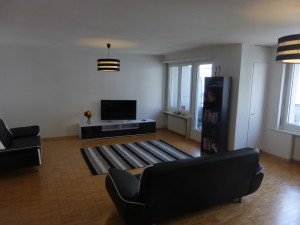
If you’ve wondered why things here on the blog have been quiet for the last several months, we’ve recently just finished a big move and furnishing a new place. Already difficult, moving in Switzerland seems to be the ultimate challenge. Every convenience we take for granted in the U.S. is a luxury here.
Don’t take the small things for granted while moving in Switzerland
Until Feb. 1, we were in short-term or sub-leased flats. Moving every six months just didn’t allow for anything overseas to be too permanent. Since we both have jobs now and we’re settling down a bit, we decided to take the plunge and sign a year lease on a nice two-bedroom flat.
We signed the lease in mid-December, but we couldn’t pick up the keys until mid-January. That’s where we hit our first roadblock. As we were out of the country at the time, the leasing agent was very strict about when and who could pick up the keys. We couldn’t send a friend but had to be there in person to receive the extensive checklist that is given to you for minor nicks and scratches around the apartment that will be even more thoroughly inspected upon move-out.
In Switzerland, it seems it never ends with new findings and negotiations for payment of damages. When we left our temporary residence, the checklist process took hours. Like a military boot camp inspection, the landlord moves around the apartment checking for dust and exclaiming each time they find something that offends the Swiss idea of perfect cleanliness. Each minor infraction is documented and you’re reminded that if the person has to clean themselves, of course, their labor rate is higher than that of a professional cleaner. Many acquaintances have told us that they keep between 1,000 and 2,000 Swiss Francs set aside to pay for the summation of all these minor damages upon move-out.
For moving in, the biggest obstacle was the furnishings. In Switzerland, light fixtures and closets do not come built in. Light fixtures are the property of the renter, and when you move, you take chandeliers, candelabras or whatever else with you. Luckily, the last tenant left a couple of lights in place so we weren’t completely in the dark upon entry. Flats are not built with closets, so you have to purchase and assemble them (known as schranken in German speaking Europe, we’re told that these were also popular in the United States back in the 1920s) – again, taking them with you when you move out.
Furniture shopping in Switzerland
As a couple, this was a first for us. When we got married, we each brought our own furniture and just combined everything – there was very little we needed. In fact, the only piece of furniture we bought together was a dining room table and chairs.
When we took over a completely empty 108-square-meters flat and with all of our housing possessions back in the States, it was time to enter the grownup world of furniture shopping. Of course, we went straight to IKEA.
At this fail-safe store, we were able to secure a filing cabinet for our office area and a bed for our guest bedroom, but we also wanted to check out some of the other local furniture stores.
At the German discount furniture retailer, Lipo, we purchased most of our big items, like the sofas, closets, office desk and chairs, and our bed. The prices were very reasonable for what we got, but we did run into some issues. First, we were told that most of the items that had to be ordered would be in the store for pickup in about three weeks. It took double that time. Unlike our native United States, warehouses are small and each item has to be custom ordered.

When the pieces finally did arrive, since we no longer live in an environment where F150s are common, we also had to arrange a reservation for the furniture store’s truck. These are usually already booked for all convenient time slots over a two-week period. Then, when we did receive our sofas, they were incredibly difficult to put together. Legs weren’t attached yet, nails had already been driven fully into the wood where those legs should be installed, and there were no directions on what to do. Finally, the closets had several missing screws. In the end, however, we were able to improvise and get the pieces set up.
Our dining room table and two chairs (huge shout out to our friend, Christian, for giving us a set of dining room chairs to round out the table), and most of our lights and electronics came from the Swiss home furnishing store Conforama. Though the prices here were a bit higher, we were pleased with the quality of the furnishings.
In an equivalent to Lowe’s or Home Depot, to get all the tools to put together these items, we shopped at the Swiss home improvement store OBI. Set up in almost the same fashion of the DIY stores in the States, OBI had the same offerings at a much higher price. For instance, a standard drill that costs about $45 USD was 100 CHF here.
What is moving like for you?
Now that we’ve finally finished moving in Switzerland, we’re looking forward even more to enjoying our new home here. Have you ever made a move in a foreign location? What was your experience?

